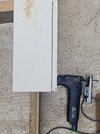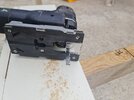Earlier today I had to fit a kitchen plinth. The floor has wibbly-wobbly floor tiles so I cut a scribing block to follow the profile of floor. I was going to use my jigsaw and then belt sand the floor edge to remove the inevitable chips in the vinyl/melamine/whatever finish. I started to cut and then I remembered that I had a bag of anti-chip plates in the jigsaw box. I pushed one in to the sole plate, turned down the speed of the jigsaw and gently tapped the plate as the blade cut through it until it was "home".

It really did make a massive difference. The jigsaw is about 10 years old. When I purchased it, it came supplied with a chip guard and a plastic cover to improve the dust extraction but I seldom use the dust extraction cover because it make it difficult to see the blade. TBH the dust extration on that particular Festool model is paints when working with timber, the ports get blocked and you have to use the Allen key to remove the sub-plate to clear the blocked side ports.
The chip plate on its own doesn't obstruct the view of the blade though. That said, every 700mm, I had to wipe the chip plate to remove the pencil marks that were being transferred from the plinth.

I am slightly annoyed with myself for having forgotten about them for so long.
Oh, and yes I am aware that if I cut from the reverse face, there would be no chipping, but that would not have been possible given the path/profile that I had to follow.

It really did make a massive difference. The jigsaw is about 10 years old. When I purchased it, it came supplied with a chip guard and a plastic cover to improve the dust extraction but I seldom use the dust extraction cover because it make it difficult to see the blade. TBH the dust extration on that particular Festool model is paints when working with timber, the ports get blocked and you have to use the Allen key to remove the sub-plate to clear the blocked side ports.
The chip plate on its own doesn't obstruct the view of the blade though. That said, every 700mm, I had to wipe the chip plate to remove the pencil marks that were being transferred from the plinth.

I am slightly annoyed with myself for having forgotten about them for so long.
Oh, and yes I am aware that if I cut from the reverse face, there would be no chipping, but that would not have been possible given the path/profile that I had to follow.

